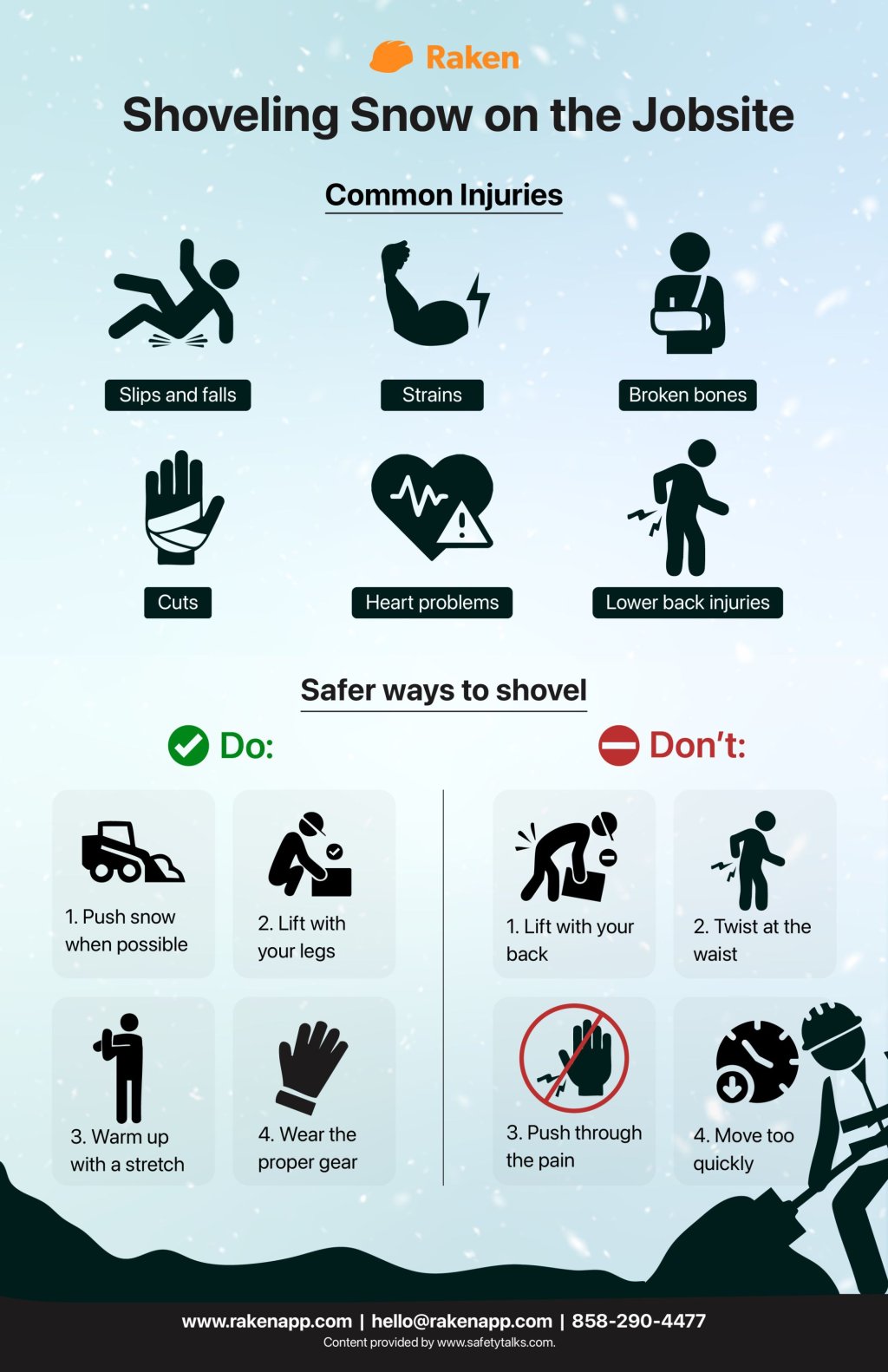Shoveling Snow Safety Talk
Winter weather brings many challenges to construction sites, including the chance of snow.
Surprisingly, a simple task like shoveling snow can result in serious injury, especially when improper form or technique are used.
Let's review best practices.
Snow shoveling injuries
If you're working outside during winter weather, you may be asked to remove snow from the construction site to clear walkways and paths for coworkers, tools, materials, vehicles, and equipment.
Here are some of the most common injuries sustained while shoveling snow:
Muscle strains
Ligament and tendon strains
Broken bones
Shoveling snow is a simple but not necessarily easy task. It can be intense labor that, if performed incorrectly, may lead to overexertion and injury. While less common than other injuries and illnesses, heart-related issues caused by shoveling snow can even result in death.
Be careful as you traverse the jobsite while shoveling snow. An accidental broken arm or head injury could easily be the consequence of a slip or fall. Obviously, snow covering the walking surfaces of a jobsite increases the odds of slips and falls itself, but snow also hides the ground and objects underneath it. This makes the risk of tripping and falling even more likely.
How should I safely shovel snow?
Here are some best practices for everyone in construction who may deal with snow on the jobsite.
Pushing snow is safer than shoveling snow
When it comes to safety, the goal is to work smarter, not harder. Use snow blowers, plows, and other mechanical tools whenever possible to minimize physical stress on your body when removing snow from the jobsite. Even if you must use a shovel, you can push the snow instead of lifting it.
When you push snow or use a blower, you don’t have to throw it off your shovel, which typically involves a risky twisting motion. You'll use less muscle and keep exertion to a minimum.
Most lower back injuries in the construction field come from physically lifting a load and twisting your upper body at the same time. Avoid this incorrect type of lifting and throwing at all costs.
Heavy lifting with your legs
You have likely heard that all heavy lifting should be done with your legs, not your back, in a straight vertical line. When you bend down to shovel or lift snow, take a shoulder-width stance, bend at your hips and knees, and sink your bottom down while keeping your back straight and your head up.
This should put you in the proper position to use your legs for lifting, protecting your back muscles.
When moving heavy loads, turn with your hips and feet
Lifting and twisting a load with your back is a surefire way to injure yourself. Once you have the load in your hands and off the ground, turn with your legs and lower body to face the direction your load needs to go to keep your back from twisting under load.
Warm-up and prepare for a marathon, not a sprint
Take time to ease into the hard work of shoveling snow. Start slow and light and make sure you're ready to work in cold weather. Stretch your muscles only after you've warmed up. Don't overexert yourself with overly heavy loads to finish in less time, especially if you are not used to heavy labor.
Be prepared to take breaks and catch your breath. If you start to feel faint or become short of breath, or you know you have health issues, consider having someone else shovel snow for you. Adults over 55 are much more likely than younger people to have heart-related symptoms while shoveling snow.
Don’t push through the pain
Take pain seriously. Shoveling snow on the jobsite is a labor-intensive task.
Muscle strains and soft tissue injuries are common. This is likely because shoveling snow is a unique physical activity that only happens during specific months of the year. Consequently, your body is likely not used to the activity and needs time to adapt.
Don’t try to push through any pain you develop when shoveling snow. Pain should be treated as an indication of physical damage, and you should stop shoveling before serious injuries happen.
Wear the proper gear
Protective clothing on the construction site includes proper winter gear. Clothes should be heavy enough to prevent overexposure to the cold as well as maintain safety standards required by OSHA and your construction company.
Winter footwear needs to promote traction on slippery surfaces. Snow often hides ice underneath.
Take care when walking and shoveling snow on the jobsite. Smaller, slower steps can help you maintain your balance should your feet slip out from under you. Installing handrails where possible or structures that can work like handrails in slippery conditions can help.

Talk about the safe way to shovel snow
There is a wide spectrum of injuries that can happen as a result of shoveling snow in an unsafe manner for construction workers and tradespeople. It is easy to overlook the basic safe practices for:
Proper lifting technique
Moving heavy loads
Working in slippery conditions
Working on construction sites
On the surface, shoveling snow can seem like an easy, mindless task. But, like everything else in the construction zone, doing it safely takes awareness and knowledge of best practices to prevent accidental injuries.
Find and schedule topics faster
Raken's toolbox talk app makes it easy to choose from a pre-loaded library (or upload your own), then schedule and assign topics for any project. We'd love to show you how in a demo and get you started on a free trial.